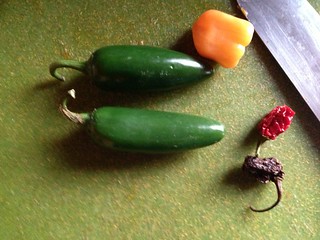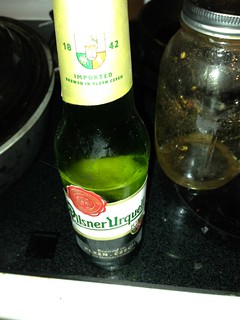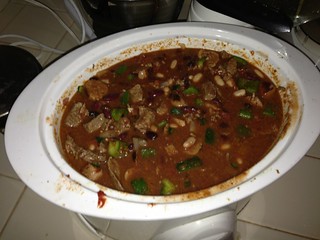Skill time! When pondering on what next to post, my lovely wife pointed out I was in the middle of making a chili, so why not talk about that? It ties in a bit with my friend Ann's blog,
Shopping in my basement as it can be made up with food you've put up. I love making up large pots of food during the winter and freezing portions for later, like chili, stew, or pot roasts, so here's a peek at one of them.
I think a lot of us are familiar with crock pot cooking. For those who aren't, it's one of the easiest ways to turn out an awesome meal with less work. Crock pots (technically "slow cookers", Crock Pot is a name brand) are easy to find. Chances are you can ask your friends and relatives and some one has one in their basement. In fact, if you're married, check your put aside gifts, you probably have one tucked away. Mine is a large 6 quart model that fits a lot of food. I've pretty well figured out the proportions by making my first stew from the included recipe book, then making up my own from there. What follows is as much of a recipe as I ever really use; I'm very much an improvisational cook.
Chili is a personal favorite of mine as every time is a little different for me. Different ingredients are available based on what's in my pantry, on sale at the store, or tickling my fancy. Thus it really becomes a quest to make the perfect chili, knowing I may never be satisfied. Major variables tend to be the meat (or lack thereof), overall heat factor (I LOVE spicy food, but not everyone can eat my level of spice), and the vegetables in season or stored. Based on what I have this time, I made what I'm calling...
New England Winter Warmer
Ingredients
1 pound spicy sausage
1 pound ground beef
1.5 pounds stew meat, cut into 1"x1/2" pieces
1 large onion
4+ cloves chopped garlic (my favorite vegetable)
2 cans Red Kidney beans (I usually use dry, but was lazy and forgot to soak)
1 can White Kidney beans
1 can Black beans
2 green bell peppers
2 Jalapeno peppers
1 Habenero pepper
1/2 dried ghost pepper
1 dried red pepper (not sure what kind. I have an assortment of dried peppers I pull from)
1 bottle Pilsner Urquell beer
1.5 quarts stewed tomatoes (put up from last year)
1 can tomato paste
1 tbsp Mexican-style chili powder
1/2 tbsp chili powder
1/2 tbsp dried Cilantro
1/2 tbsp smoked salt (magic, this stuff!)
1 tsp hot smoked paprika
1 tsp mild smoked paprika
1 tbsp course ground pepper
1 heaping tbsp real maple syrup
Step 1
Begin by browning up the meats. The sausage will take the longest as it needs to cook through. If it isn't cooked brown all the through, it will finish in the chili. Just make sure it isn't raw in the middle and things should be fine.
 I never sau-sage nice browning!
I never sau-sage nice browning!
I like to throw the onions and garlic in with the ground beef while it browns to mellow them out a bit while imparting flavor to the meat. Chop up the garlic first...
 My favorite vegetable
My favorite vegetable
...then throw it in with the ground beef. Make sure you drain your meat before adding it to the slow cooker as liquid fat isn't tasty. At this point, you can use the beer to de-glaze the pan. This time I opted not to, as I wanted slightly lighter, sweeter chili. Add all the meats into the slow cooker.
If I were doing this solely from preps, this could be done with
Freeze Dried ground beef or canned meat of many types.
Step 2
Chop up your peppers and add them to the pot.
 Small, but potent
Small, but potent
When chopping your green peppers, remove the seeds and the connective tissue inside the peppers, the white, spongy stuff. The same is true for the hot peppers, but I STRONGLY advise putting on rubber gloves before handling them.
Capsaicin is a nasty chemical and will cling to your fingers long after you have washed your hands 2 or 3 times. Then, next time you rub your eyes or nose, you will essentially pepper spray yourself. Trust me, it isn't fun!
 Two by Two, hands of blue
Two by Two, hands of blue
I like to chop the bell peppers fairly large, about 1/2" squares, the jalapenos in half then slices, and the small peppers I chop fine. This means someone is less likely to get bite down on a serious amount of heat! I also like to remove the seeds and connective tissue in the hot peppers with a spoon, which works especially well for jalapenos
 SPOON!
SPOON!
Now pour in your beans, draining them first if they're canned. When using dried beans, I like to let the soak overnight, though you can also cook them in lots of water to speed up the process. Read your package directions for best results.
Done from long-term stored food, dehydrate your own, or grab
bell peppers here and use dried hot peppers for the rest.
Step 3
Time to add the spices and liquid to the mix! I like to put the spices in first so the liquids will carry them around. No particular order here, and add freshly ground spices if you can. During the summer I use a lot more fresh, green spices, but winter calls for dried. That's the main reasons the amounts are as high as they are, since dried spices (especially old ones) don't pack as much punch.
Now the liquids. Home canned tomatoes...
 See, we were worth the hours of work and steam burns!
See, we were worth the hours of work and steam burns!
and the beer.
 The best beer in the Czech Republic. Out of 2 beers...
The best beer in the Czech Republic. Out of 2 beers...
Throw in you maple syrup, and slap a lid on it!.
 Primordial Chili
Step 4
Primordial Chili
Step 4
Put it on to cook. This is where a slow cooker shines. When I have time, I like to set it on low for 8 hours, often timing it to start in the morning and be ready in time for dinner. Many slow cookers even have delayed time settings to make this easier. Put your chili in the fridge overnight, put it on in the morning, then enjoy when you get home. Serve with bread or rice if desired.
Once you figure out a nice base, you can mix it up next time as you continue searching for that perfect chili! So, what's your favorite winter slow-cooker food? I know I'm always open to ideas, so share them below.
 I never sau-sage nice browning!
I like to throw the onions and garlic in with the ground beef while it browns to mellow them out a bit while imparting flavor to the meat. Chop up the garlic first...
I never sau-sage nice browning!
I like to throw the onions and garlic in with the ground beef while it browns to mellow them out a bit while imparting flavor to the meat. Chop up the garlic first...
 My favorite vegetable
...then throw it in with the ground beef. Make sure you drain your meat before adding it to the slow cooker as liquid fat isn't tasty. At this point, you can use the beer to de-glaze the pan. This time I opted not to, as I wanted slightly lighter, sweeter chili. Add all the meats into the slow cooker.
If I were doing this solely from preps, this could be done with Freeze Dried ground beef or canned meat of many types.
Step 2
Chop up your peppers and add them to the pot.
My favorite vegetable
...then throw it in with the ground beef. Make sure you drain your meat before adding it to the slow cooker as liquid fat isn't tasty. At this point, you can use the beer to de-glaze the pan. This time I opted not to, as I wanted slightly lighter, sweeter chili. Add all the meats into the slow cooker.
If I were doing this solely from preps, this could be done with Freeze Dried ground beef or canned meat of many types.
Step 2
Chop up your peppers and add them to the pot.
 Small, but potent
When chopping your green peppers, remove the seeds and the connective tissue inside the peppers, the white, spongy stuff. The same is true for the hot peppers, but I STRONGLY advise putting on rubber gloves before handling them. Capsaicin is a nasty chemical and will cling to your fingers long after you have washed your hands 2 or 3 times. Then, next time you rub your eyes or nose, you will essentially pepper spray yourself. Trust me, it isn't fun!
Small, but potent
When chopping your green peppers, remove the seeds and the connective tissue inside the peppers, the white, spongy stuff. The same is true for the hot peppers, but I STRONGLY advise putting on rubber gloves before handling them. Capsaicin is a nasty chemical and will cling to your fingers long after you have washed your hands 2 or 3 times. Then, next time you rub your eyes or nose, you will essentially pepper spray yourself. Trust me, it isn't fun!
 Two by Two, hands of blue
I like to chop the bell peppers fairly large, about 1/2" squares, the jalapenos in half then slices, and the small peppers I chop fine. This means someone is less likely to get bite down on a serious amount of heat! I also like to remove the seeds and connective tissue in the hot peppers with a spoon, which works especially well for jalapenos
Two by Two, hands of blue
I like to chop the bell peppers fairly large, about 1/2" squares, the jalapenos in half then slices, and the small peppers I chop fine. This means someone is less likely to get bite down on a serious amount of heat! I also like to remove the seeds and connective tissue in the hot peppers with a spoon, which works especially well for jalapenos
 SPOON!
Now pour in your beans, draining them first if they're canned. When using dried beans, I like to let the soak overnight, though you can also cook them in lots of water to speed up the process. Read your package directions for best results.
Done from long-term stored food, dehydrate your own, or grab bell peppers here and use dried hot peppers for the rest.
Step 3
Time to add the spices and liquid to the mix! I like to put the spices in first so the liquids will carry them around. No particular order here, and add freshly ground spices if you can. During the summer I use a lot more fresh, green spices, but winter calls for dried. That's the main reasons the amounts are as high as they are, since dried spices (especially old ones) don't pack as much punch.
Now the liquids. Home canned tomatoes...
SPOON!
Now pour in your beans, draining them first if they're canned. When using dried beans, I like to let the soak overnight, though you can also cook them in lots of water to speed up the process. Read your package directions for best results.
Done from long-term stored food, dehydrate your own, or grab bell peppers here and use dried hot peppers for the rest.
Step 3
Time to add the spices and liquid to the mix! I like to put the spices in first so the liquids will carry them around. No particular order here, and add freshly ground spices if you can. During the summer I use a lot more fresh, green spices, but winter calls for dried. That's the main reasons the amounts are as high as they are, since dried spices (especially old ones) don't pack as much punch.
Now the liquids. Home canned tomatoes...
 See, we were worth the hours of work and steam burns!
and the beer.
See, we were worth the hours of work and steam burns!
and the beer.
 The best beer in the Czech Republic. Out of 2 beers...
Throw in you maple syrup, and slap a lid on it!.
The best beer in the Czech Republic. Out of 2 beers...
Throw in you maple syrup, and slap a lid on it!.
 Primordial Chili
Step 4
Put it on to cook. This is where a slow cooker shines. When I have time, I like to set it on low for 8 hours, often timing it to start in the morning and be ready in time for dinner. Many slow cookers even have delayed time settings to make this easier. Put your chili in the fridge overnight, put it on in the morning, then enjoy when you get home. Serve with bread or rice if desired.
Once you figure out a nice base, you can mix it up next time as you continue searching for that perfect chili! So, what's your favorite winter slow-cooker food? I know I'm always open to ideas, so share them below.
Primordial Chili
Step 4
Put it on to cook. This is where a slow cooker shines. When I have time, I like to set it on low for 8 hours, often timing it to start in the morning and be ready in time for dinner. Many slow cookers even have delayed time settings to make this easier. Put your chili in the fridge overnight, put it on in the morning, then enjoy when you get home. Serve with bread or rice if desired.
Once you figure out a nice base, you can mix it up next time as you continue searching for that perfect chili! So, what's your favorite winter slow-cooker food? I know I'm always open to ideas, so share them below.
My typical chili is not done slow cooker, but is put into a low heating oven, as I think you know. I also use a beautiful cast iron dutch oven, which helps the situation.
ReplyDeleteMy base is also typically a mix of ground beef and ground turkey, which has led to enough richness of flavor and still leanness of eating so that the chili is healthier. If I have other meat, venison or moose, etc, I'll add that in as well, with a combination of others. My inclusion of beans is most often based on how much space is available after meat, tomato and other veggies have been thrown in.
But hey, ask 100 people for their chili recipe and you'll find 100 recipes! :)
Exactly! Or, like us, ask 2 people and get 25 recipes! :)
Delete